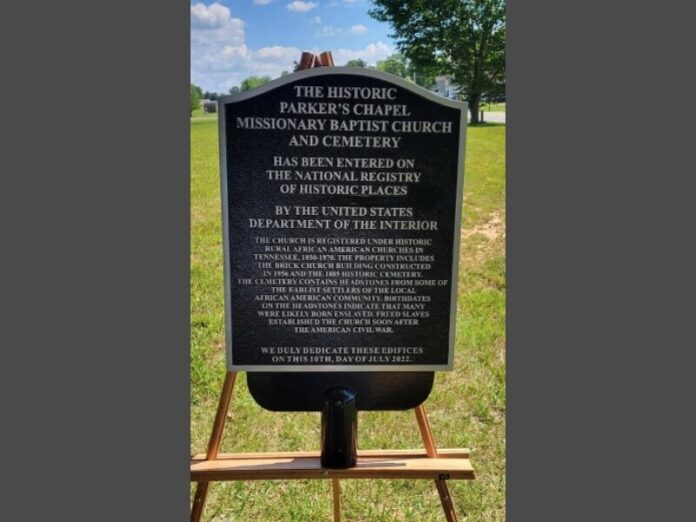The area in Portland, Tennessee known as Parker’s Chapel was once a separate community that was started by a group of ex-slaves after the Civil War. It began when Sam and Lucinda Coakley came with their children from Robertson County. They were followed by other ex-slave families, including the Smiths, Perdues, the Dyes, the Hobdys, and the Gibbs families. Many of their descendants still live in the area.
Everyone worked hard, and Parker’s Chapel became a strong farming community where most of the residents owned their own land, purchased for fifty cents per acre. Mostly they grew tobacco. They also had gardens and as time went by, the area became known for growing strawberries.
Initially, they started having church services in each other’s homes. Then about 1870, the community had grown to the point that they decided they needed a church. It also became the community’s first school.
Eventually, there was not only the church, but they built a separate school, a blacksmith shop, a grocery and a cemetery. According to an article on rootsweb.com, “Luther Coakley ran the blacksmith shop for the community. Grocery stores were managed at intervals by Jim Rippy, Cagie Coakley, Gilmore Coakley and Lucy Whiteside as a means for making a living. Many homes in the early community were built by the Coakley brothers.”
Originally, the area that became known as Parker’s Chapel was called “Taylor’s Old Field”, and then “Old Field,” because the land had been owned by a man named Tayor. It took on the name Parker’s Chapel in honor of the first pastor, the Reverend James Parker.
That first church was built from logs cut and hewed out by members of the community. They worked together to build a log chapel to serve the growing flock. As the population continued to grow, so did the need for a larger church building. The second church was a white frame building with a pot-bellied stove, kerosene lights, pews, a piano and a pulpit. The school was moved to a separate building.
According to the Tennessee Encyclopedia, “The present church building, constructed [of asbestos siding] in 1956-57, and bricked in 1970, is the third building on this site.” The third building offered a sanctuary and Sunday School classrooms. Later additions to it in the 1970s included a Baptistery and a Pastor’s Study.
While the church still stands, the old school does not. It had been a Rosenwald school. The two-room building provided space for first through eighth grade. The rootsweb.com article adds that, “The citizens of Parker’s Chapel raised six hundred dollars, and the county supplied the land. With a gift of twelve hundred dollars from the Julius Rosenwald Fund, the school was built in 1923 and used until 1960. After that and until 1965, when the Portland school desegregated, the African American children of Parker’s Chapel were bused to Gallatin, the county seat.”
Parker’s Chapel was still very much a separate community in the 1940s, but the area has since been engulfed by the city of Portland, and now only a street, the church and the cemetery bear the name.
In 2021, with the increase in interest in preserving more exclusively African-American history, Parker’s Chapel Baptist Church and Cemetery in Portland, Tennessee, was listed on the National Register of Historic Places.
According to the National Registry of Historic Places application, currently, “The Portland Municipal Airport owns the land that borders the Parker’s Chapel property to the north, east, and south…The empty lot that borders the Parker’s Chapel property to the north was the site of the circa 1923 non-extant Parker’s Chapel Rosenwald School; the fellowship hall now sits at the south end of this parcel…Airport Road borders the property to the west, across which there are single family homes built from the mid-to-late twentieth century.”
The application goes on to describe the adjoining cemetery, “Located directly south of the church building is the historic cemetery. The cemetery contains headstones from some of the earliest settlers of this African American community, including graves from the Coakley, Dye, Gibbs, Perdue, Smith, and Johns families. Many of the stones have birth dates from the early to middle nineteenth century, indicating many of the interred were likely born enslaved. The earliest marked burial is Abraham Perdue, whose stone states: “son of Lucy Perdue died 11 Aug 1885 age 25 years 10 months 3 days.” There are nearly one hundred markers dating to the early-to-mid-twentieth century located in loosely organized rows.“



























